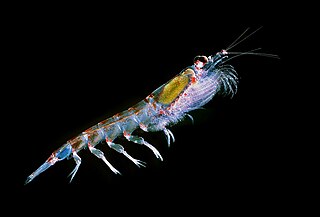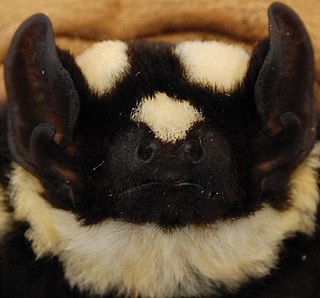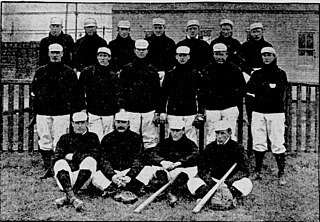
Antarctic krill is a species of krill found in the Antarctic waters of the Southern Ocean. It is a small, swimming crustacean that lives in large schools, called swarms, sometimes reaching densities of 10,000–30,000 animals per cubic metre. It feeds directly on minute phytoplankton, thereby using the primary production energy that phytoplankton originally derive from the sun in order to sustain its pelagic life cycle. It grows to a length of 6 centimetres (2.4 in), weighs up to 2 grams (0.071 oz), and can live for up to six years. A key species in the Antarctic ecosystem and in terms of biomass, E. superba is one of the most abundant animal species on the planet, with a cumulative biomass of approximately 500 million metric tons.

Krill(Euphausiids) are small and exclusively marine crustaceans of the order Euphausiacea, found in all the world's oceans. The name "krill" comes from the Norwegian word krill, meaning "small fry of fish", which is also often attributed to species of fish.

Chaenomeles is a genus of four species of deciduous spiny shrubs, usually 1–3 m tall, in the family Rosaceae. They are native to Southeast Asia. These plants are related to the quince and the Chinese quince, differing in the serrated leaves that lack fuzz, and in the flowers, borne in clusters, having deciduous sepals and styles that are connate at the base.

The hybrid elm cultivar Ulmus × hollandica 'Superba' is one of a number of intermediate forms arising from the crossing of the Wych Elm U. glabra with a variety of Field Elm U. minor. Boulger tentatively (1881) and Green more confidently (1964) equated it with a hybrid elm cultivated in the UK by Masters at Canterbury in the early 19th century, known as "Masters' Canterbury Seedling" or simply the Canterbury Elm. Loudon examined a specimen sent by Masters and considered it a hybrid, calling it U. montana glabra major.

The pied butterfly bat, also known as the pied bat or badger bat, is a rare species of vesper bat in the family Vespertilionidae.
The 1904 Brooklyn Superbas finished in sixth place with a 65–97 record.

The 1901 Brooklyn Superbas lost several players to the newly official major league, the American League, and fell to third place.
The 1900 Brooklyn Superbas captured their second consecutive National League championship by four and a half games. The Baltimore Orioles, which had been owned by the same group, folded after the 1899 season when such arrangements were outlawed, and a number of the Orioles' players, including star pitcher Joe McGinnity, were reassigned to the Superbas.

Elmer Griffin Stricklett was an American professional baseball pitcher. He pitched in Major League Baseball for the Chicago White Sox and Brooklyn Superbas from 1904 through 1907. Including his time in minor league baseball, Stricklett pitched professionally from 1897 through 1912.
The 1899 Brooklyn Superbas season was the 16th season of the current-day Dodgers franchise and the ninth season in the National League. The team won the National League pennant with a record of 101–47, 8 games ahead of the Boston Beaneaters, after finishing tenth in 1898.
The elm cultivar Ulmus × hollandica 'Blandford' was listed by the Urban Forestry Administration (UFA) of the District Department of Transportation in Washington, D.C., as one of its 'street trees' in 2008. As the UFA has no further documentation to support it, the entry may be spurious, but it is most likely the tree is the wych elm cultivar Ulmus glabra 'Superba', known in the UK as the 'Blandford Elm' and introduced to the US in the early 20th century, or possibly the hybrid cultivar Ulmus × hollandica 'Superba' present in some American collections, including Garfield Park, Washington, D.C., in the mid-20th century.

The Brooklyn Dodgers were a Major League Baseball team founded in 1883 as the Brooklyn Grays. In 1884, it became a member of the American Association as the Brooklyn Atlantics before joining the National League in 1890. They remained in Brooklyn, New York, until 1957, after which the club moved to Los Angeles, California, where it continues its history as the Los Angeles Dodgers. The team moved west at the same time as its longtime rival, the New York Giants, moved to San Francisco in northern California as the San Francisco Giants.

Gloriosa superba is a species of flowering plant in the family Colchicaceae. Common names include flame lily, climbing lily, creeping lily, glory lily, gloriosa lily, tiger claw, and fire lily.

The wych elm cultivar Ulmus glabraHuds. 'Superba', Blandford Elm, with unusually large leaves, was raised by Gill's of Blandford Forum, Dorset, in the early 1840s as Ulmus montana superba and was quickly distributed to other UK nurseries. It was confirmed as a form of wych, and first described by Lindley in The Gardeners' Chronicle, 1845, later descriptions being added by Gill (1845) and Morren (1848), who called it U. montana var. superba. Morren had adopted the name 'Superba' from the Fulham nurseryman Osborne in 1844, who supplied him with the tree – presumably one of the nurseries supplied by Gill. Morren states that 'Superba', already in cultivation in England, was introduced to Belgium by Denis Henrard of Saint Walburge, Liège, that in 1848 it had been present in Belgium for only three years, and that this variety was the one described as 'Superba' by Osborne, whom Henrard had visited at his nursery in Fulham in September 1844. 'Blandford Elm', with leaves of the same dimensions, was soon for sale in the USA.

Eucerceris provancheri is a species of wasp in the family Philanthidae. It is found in Central America and North America.
Eucerceris is a genus of wasps in the family Philanthidae. There are more than 40 described species in Eucerceris.
Eucerceris canaliculata is a species of wasp in the family Philanthidae. It is found in North America.
Philaronia is a genus of spittlebugs in the family Aphrophoridae. There are about five described species in Philaronia.
Eucerceris arenaria is a species of wasp in the family Philanthidae. It is found in North America.
Eucerceris flavocincta is a species of wasp in the family Philanthidae. It is found in North America.










